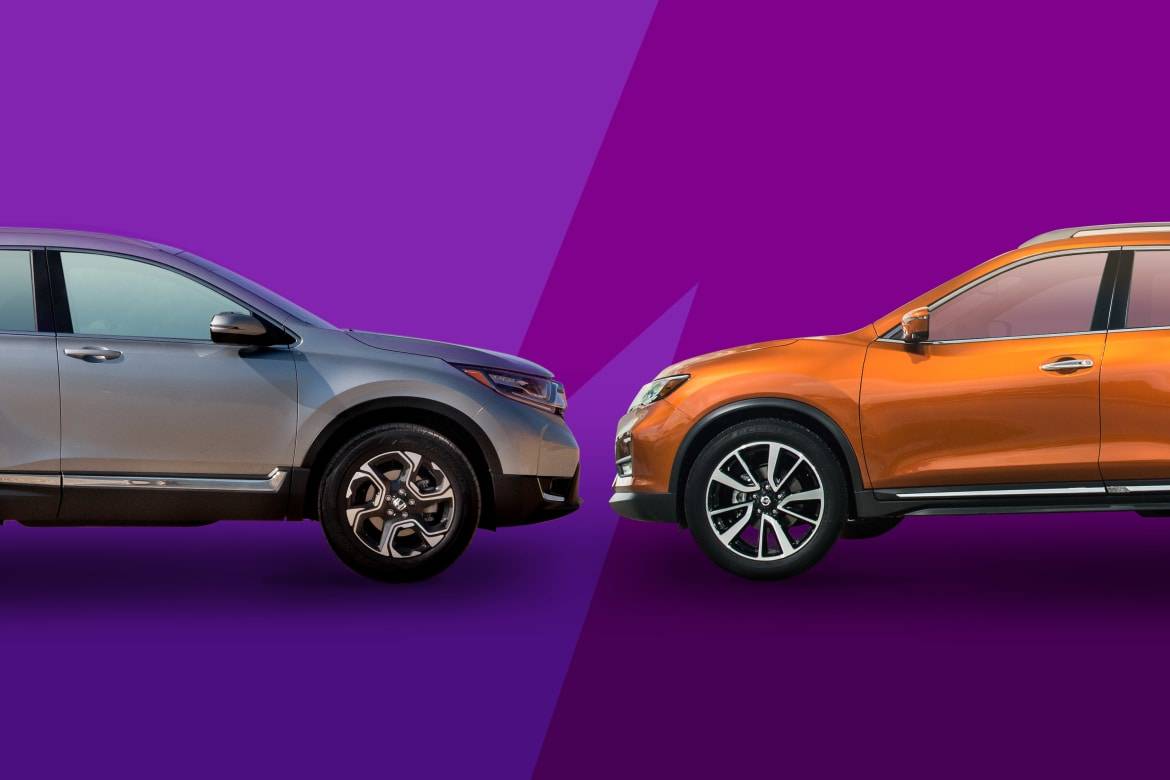2017 Honda CR-V Vs. 2017 Nissan Rogue: Review Faceoff


CARS.COM — If you’re looking for a compact SUV, chances are high that the Honda CR-V or Nissan Rogue are on your shopping list. These best-selling compact SUVs have plenty to offer shoppers in the market for a new vehicle.
Related: What’s the Best Compact SUV of 2016?
For 2017, the Nissan Rogue receives styling and interior updates, additional sound insulation and a new hybrid model, and the Honda CR-V is redesigned with fresh styling, larger dimensions — the wheelbase has been stretched 1.6 inches — and a new engine.
For both vehicle models, all trim levels are available with front- or all-wheel drive. Cars.com’s staff tested the most expensive versions, a Honda CR-V Touring and a Nissan Rogue SL, both with AWD. How do these SUVs compare? Our expert reviewers dig in and pick a champion. Will it be the Nissan or the Honda SUV?
Read the Honda CR-V Expert Review | Find a 2017 CR-V for Sale Near You
Read the Nissan Rogue Expert Review | Find a 2017 Rogue for Sale Near You
On the Road
The Nissan Rogue: Its 170-horsepower, 2.5-liter four-cylinder engine with a continuously variable automatic transmission delivers somewhat lazy acceleration unless you press hard on the gas pedal in this vehicle. That’s when the CVT acts like a conventional transmission, simulating a downshift to perk up the acceleration. The Rogue has an absorbent suspension for commendable ride comfort, even with the optional 19-inch tires available on the SL model.
The Honda CR-V: It now offers a choice of engines, but neither has impressive acceleration. LX trims have the same 184-hp, 2.4-liter four-cylinder from the previous generation, and EX models and above use a new 190-hp, turbocharged 1.5-liter four-cylinder; both come with a CVT. The turbo engine marginally improves acceleration, but off the line, the CR-V feels ponderous. The CR-V transmission is slow to change gear ratios and deliver highway passing power. Handling, though, is more responsive thanks to sharper steering, and ride comfort is improved over broken pavement compared to the previous CR-V.
The winner? The Nissan Rogue nabs its first win.
Family Fit
The Nissan Rogue: It comes in two or three rows. In two-row models, The 40/20/40-split second row reclines and slides fore and aft, a useful feature if you want to enlarge the cargo space or pull a child in a car seat closer to the front row of the vehicle. The optional third row increases seating to seven, but it’s sized more for kids than adults and leaves a scant 9.4 cubic feet of cargo space behind it when in use. Two-row Rogues have 39.3 cubic feet of cargo space behind the backseat, and there’s also the nifty Divide-N-Hide storage system with two partitions and 18 adjustable configurations to organize the area. Fold the rear seats and the Rogue has a competitive 70 cubic feet of maximum cargo space.
The Honda CR-V: It seats five, and the 60/40-split folding backseat now folds flat. The rear seatbacks recline, but they don’t slide forward and back as in the Nissan Rogue. However, rear legroom has grown by 2.1 inches for a total of 40.4 inches, compared with the Rogue’s 37.9 inches. The CR-V has 39.2 cubic feet of cargo space behind the rear seats, and maximum cargo volume is 75.8 cubic feet. The cargo area also has a two-step floor that can be raised or lowered a few inches to fit taller objects.
The winner? Honda CR-V drives home with this one.
Technology and Entertainment
The Nissan Rogue: It comes with a 5-inch multimedia display, backup camera, satellite radio, and Bluetooth phone and audio streaming as standard, but the multimedia options beyond that are generally disappointing in this vehicle. With the optional 7-inch touchscreen, the graphics are run-of-the-mill, and the nav system lacks pinch-to-zoom map functionality. Moreover, Android Auto and Apple CarPlay — readily available among the Rogue’s rivals — aren’t offered, and there’s just one USB port. A 360-degree camera system is standard on the SL and optional on the SV.
The Honda CR-V: LX models have a rudimentary media system with a 5-inch screen, but EX vehicle models and higher get a 7-inch screen and Honda’s Display Audio system, which has been much maligned by our editors. However, for 2017, it has a volume knob that makes it easier to use, and it comes with standard Android Auto and Apple CarPlay. All models have two standard 12-volt power outlets up front, and LX models have one USB port. On the EX and higher, there’s an additional USB port for charging only in the front storage area, plus a pair of USB ports on the center console.
The winner? Honda CR-V takes this category.
Value
The Nissan Rogue: Nissan’s compact SUV checks a lot of boxes for small families, with above-average reliability to boot, so it’s a worthy contender.
The Honda CR-V: It has plenty of passenger and cargo space, a well-appointed interior with an abundance of charging ports and a solid reputation for reliability and resale value as an SUV.
The winner? It’s a tie.
Overall winner: The Honda CR-V won 3 of 4 categories and claims the ribbon.
Cars.com’s Editorial department is your source for automotive news and reviews. In line with Cars.com’s long-standing ethics policy, editors and reviewers don’t accept gifts or free trips from automakers. The Editorial department is independent of Cars.com’s advertising, sales and sponsored content departments.

Contributor Rick Popely has covered the auto industry for decades and hosts a weekly online radio show on TalkZone.com.
Featured stories




